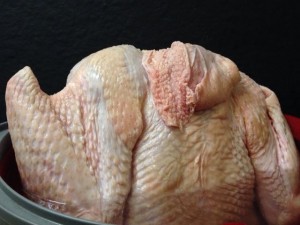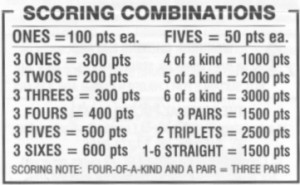
Click for Thanksgiving ’14 Pix.
We learned a new dice game from Bob & Bev and enjoyed it immensely. Our version is an adaptation from other similar games. A popular variant is called Chicken and Farkle. Our dear friend Goly suggested naming it Turkey because, as she so eloquently put it, “the game should be called Turkey on Thanksgiving, and when someone chickens out (bugh bugh bugh) we should all say gobble gobble gobble :-).”
Getting Started
Requires: Six dice, paper for scoring
Goal: Reach 10,000 points (one version requires landing on 10,000 EXACTLY!)
There is no restriction to the number of players.
To begin, all players roll one die—high roll goes first.
The following dice are called COUNTERS (followed by their respective score):
5 = 50 points
1 = 100 points
Combination Scores
Three of a kind in a single roll = 100 x that number (for example: three 2s = 200, three 5s = 500, etc.). The exception to this rule is three 1’s in a single roll = 1,000 points. On a subsequent roll, if an additional die matches a previously thrown 3-of-a-kind, it doubles the score of the previously thrown 3-of-a-kind.

Dice are scored at the time they are rolled, so three or more of a kind must be rolled simultaneously, and dice from later rolls do not “stack” for the higher score.
The Play:
To start your turn, roll all six dice. Look for counters in your roll. You must score 500 points to “get on the table” (at which point you start to keep track of your score). On subsequent turns, a minimum score of 350 must be rolled to record any points for that turn. If you haven’t rolled any counters (1 or a 5), that is the end of your turn. To continue, you must set aside at least 1 counter before rolling again. Note: you’re NOT required to keep all counters rolled (thereby increasing your odds of rolling 3-of-a-kind on a subsequent roll). However, you may not pick some counters and leave the rest without re-rolling (this only comes into play when attempting to land on 10,000 points exactly).
If on 1 or more throws all six thrown dice are “good” (points), you have “hot dice” and can throw all six dice again to further increase their score. As on the first roll, if this subsequent roll doesn’t contain any counters, your turn ends and you get NO score (regardless of how many points you accumulated during your turn).
You may choose to stop rolling at any time. (Hence the nickname “chicken”). If you choose to stop rolling, you take all points accumulated so far in addition to any points you have for counters still on the table. If you continue to roll, you take the chance at losing your points if you do not roll at least one counter on a subsequent roll.
In a variant described as “piggybacking”, each player after the first can choose to begin their turn either with a fresh set of six dice or by throwing the DICE REMAINING after the previous player has completed her turn.
Piggybacking
If a player banks three 6’s for a score of 600 and chooses stop there, the next player may choose to roll the remaining three dice. If s/he rolls at least one counter, s/he scores 600 plus whatever additional score s/he accumulates. Players may thus assume the greater risk of rolling zip for the chance of scoring the points already accumulated by the player before them. If a player ends their turn on a “hot dice”, the next player may “piggyback” using all six dice (with no penalty to the previous player other than the verbal abuse).
To win, you must end your game with exactly 10,000 points. Posturing yourself as you near the 10,000 goal is part of the strategy. If you’re sitting on 9,950 points, a roll with a SINGLE 5 is a winning thrown. In that situation, if 2 counters are rolled, you forfeit accumulated points and your turn is over.
You are not required to keep all the counters you roll, even in your final attempt to reach 10,000, but you cannot leave any counters on the table! (If you are trying to roll 200 points, but you roll 250 points worth of counters, you have gone over if you take all the points.) You MAY, however, pick up only part of those points and re-roll the remaining dice in hopes of trying to roll exactly what is needed on the subsequent roll).
Note: there are different ways to score a roll. For example, if you roll 2, 2, 2, 2, 3, 3 you could use that as a four of a kind, take 300, and quit. OR take the 300 and roll the remaining two dice. OR you could take it as three pairs, take 1,200 points, and roll ALL the dice. Doing this gives you more points, and a greater chance at rolling more counters in the next roll. If you are close to your 10,000 point mark and 1,200 would put you over 10,000, it would be better to take the 300.
You cannot combine scores from different rolls to make a larger roll score. For example, if a 5 is thrown in the first roll and removed from the active dice as a score of 50, and then 2 more 5’s are rolled in the next turn, the player can’t make this a triple and score 500. The score at this point would be 150. Triples and straights must be rolled in one roll.
Sample Rolls:
1st roll: 6 2 3 1 1 5
You could keep either of the 1’s, the 5, all three of these, or any combination of these. Strategy: keep one-1 and roll five dice hoping for three-of-a-kind. (Running score 100.)
2nd roll: 3 3 3 4 6
Keep all the 3’s (300 pts), Current score now 400 (100 from 1st roll + 300 from 2nd roll) If this is your first turn or you are not “on the table” yet and have no choice but to continue rolling to get the required 500 points (necessary to begin accumulating score). (Running score 400)
3rd roll: 1 4
You save the 1 (making your running score 500) and quit the turn. The odds of rolling the final die and getting a counter is slim and you could lose ALL your accumulated points. (Were you to fail to roll a 1 or a 5 on this 3rd roll, your turn is over and you score NO points.)
